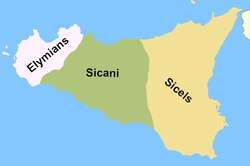Sicani

The Sicani (Greek Sikanoi) or Sicanians were an Ancient tribe of Sicily (Italy). It is often difficult to tell where many ancient tribes originally came from, however, the Greek scientific historian Thucydides stated that the Sicanians originated from the Iberian Peninsula.[1]
History
As well as Thucydides stating that the Sicani were of Iberian origin, there are two more common points of evidence brought up by historians to support this; evidence exists to show that the Iberians and the Sicanians had linguistic factors in common;[2] also the Ancient name of the river Segre in Catalonia was the Sicano.[3]
The Sicanians were the earliest known peoples to have inhabited Sicily, originally located in the west and central areas of the island.[4] Cave drawings have been discovered in Addaura, near Palermo from the end of the Pleistocene Epoch, around 8000 BC.[2]
During 5000 BC the nearby islands of Gozo and Malta were inhabited and colonized by people from Sicily.[5][6][7][8][9][10][11][12][13][14][15] It is likely that these people were Sicanians, due to other tribes only arriving on Sicily far later than 5000 BC,[2] the location of islands in relation to the Sicanians core location on Sicily and the existence of similar pottery being found in Agrigento and Malta from that time period.
Trade and relation to new tribes
Copper was used in some parts of Sicily by 3000 BC and bronze by 2500 BC, suggesting trade. People from Mycenean and Minoan cultures are thought to have traded in some capacity with the Sicanians.[2] In the years following, a distinct Sicanian culture existed all across Sicily, but they would soon be joined by new tribes.[2]
The Elymians were the next tribe to join the Sicanians on Sicily, they are thought to be from the Aegean.[16] Although there is no evidence of any wars between the tribes, when the Elymians settled in the north-west corner of the island, the Sicanians moved across eastwards. From mainland Italy, thought to originally have been from Liguria came the Sicels in 1200 BC; forcing the Sicanians to move back across Sicily settling in the middle of the island.[2]
Language
A few short inscriptions using the Greek alphabet have been found in the extinct Sicanian language.[17] Except for names they have not been translated, and the language is unclassified due to lack of data.[18]
References
- ^ "Sicily: Encyclopedia II - Sicily - History". Experience Festival. 7 October 2007.
{{cite news}}: Check date values in:|date=(help) - ^ a b c d e f "Sicilian Peoples: The Sicanians". Best of Sicily. 7 October 2007.
{{cite news}}: Check date values in:|date=(help) - ^ "Aapologetico de la literatura española contra los opiniones". Ensayo historico. 7 October 2007.
{{cite news}}: Check date values in:|date=(help) - ^ "Sicani e Siculi". Popoli Antichi. 7 October 2007.
{{cite news}}: Check date values in:|date=(help) - ^ Haggett, Peter. Encyclopedia of World Geography: 008. Marshall Cavendish. ISBN 0761473009.
- ^ Blouet, Brian W. A Short history of Malta. F.A. Praegar.
- ^ Aquilina, Joseph. Papers in Maltese Linguistics. University of Malta.
- ^ Bonanno, Anthony. Malta, an Archaeological Paradise: an archaeological paradise. University of Michigan.
- ^ Gannet, Henry. The National Geographic Magazine. National Geographic.
- ^ "Gozo". IslandofGozo.org. 7 October 2007.
{{cite news}}: Check date values in:|date=(help) - ^ Maringer, Johannes. The Gods of Prehistoric Man. Phoenix Press. ISBN 1842125591.
- ^ Langmead, Donald. Encyclopedia of Architectural and Engineering Feats. ABC-CLIO.
- ^ Langmead, Donald. Encyclopedia of Architectural and Engineering Feats. ABC-CLIO.
- ^ Tilley, Christopher. The Materiality of Stone: Explorations in Landscape Phenomenology. Berg Publishers. ISBN 1859738974.
- ^ Borg, Albert J. Maltese. Routledge. ISBN 0415022436.
- ^ "Sicani". Britannica.com. 7 October 2007.
{{cite news}}: Check date values in:|date=(help) - ^ The World's Writing Systems. 1996:301.
- ^ 'Sicanian' at Linguist List
